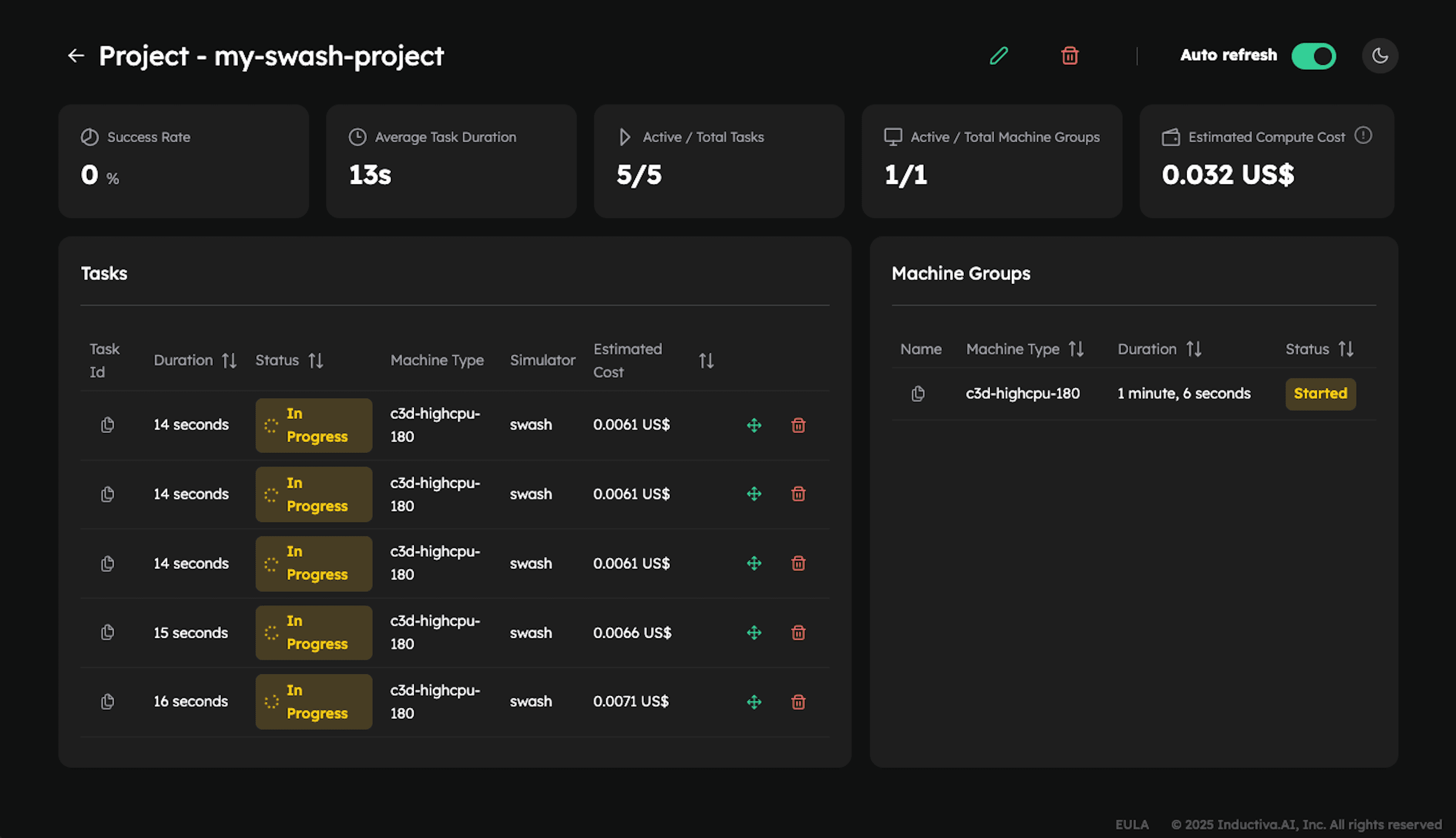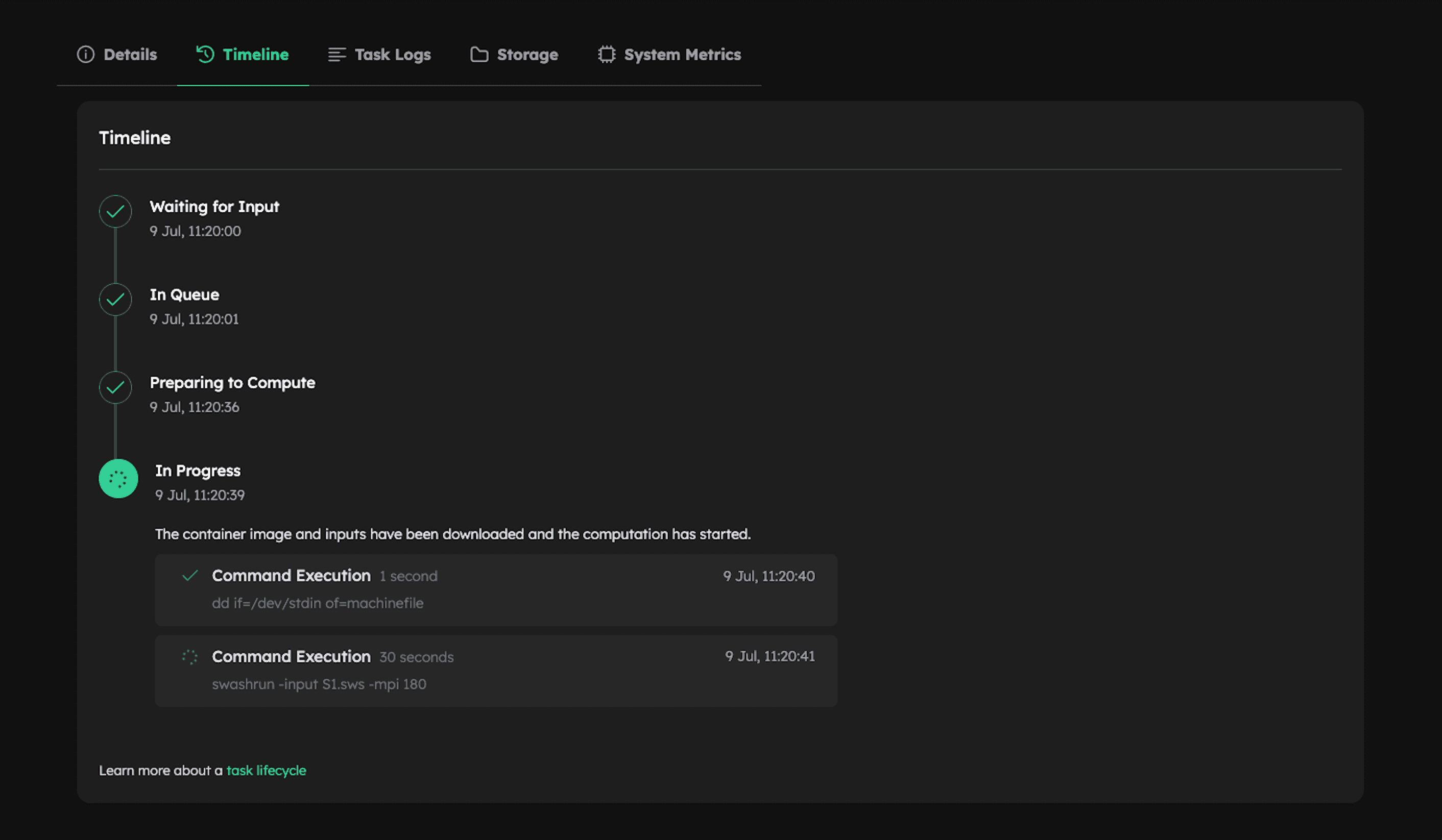Inductiva offers HPC as it should be: click, run, results.
Parallel Simulations
In this tutorial, you'll learn how to run multiple simulations in parallel, each with its own input directory, and manage them efficiently using the Inductiva API. You'll see how to submit multiple simulations to the cloud, organize them with projects and metadata, monitor their progress using the Console, and finally, download the results in a clean and automated way.
What You Will Learn
- Submit multiple simulations to run in parallel on the cloud
- Use multiple powerful machines simultaneously to speed up your simulations
- Organize all simulations under a single project
- Attach metadata to track and distinguish each simulation
- Monitor progress in real time using the Console
- Download all simulation outputs in a structured and automated way
Input Folder Structure
We assume the following folder structure:
swash-inputs/
├── swash-input-1/
│ └── S1.sws
| └── ...
├── swash-input-2/
│ └── S1.sws
| └── ...
├── ...
Each subfolder contains all the input files for a SWASH simulation.
All simulations use the same config file, named S1.sws.
Submit Simulations to Run in Parallel
Here's the full Python script to submit multiple simulations to run in parallel on the cloud:
import inductiva
import pathlib
# Define cloud resources
cloud_machine = inductiva.resources.MachineGroup(
machine_type="c3d-highcpu-180", # Machine optimized for compute-intensive tasks
num_machines=5, # Run up to 5 simulations in parallel on the cloud
spot=True, # Use cheaper spot instances (can be interrupted)
)
# Initialize simulator and project settings
swash = inductiva.simulators.SWASH(version="11.01") # Create a SWASH simulator instance
sim_config_filename = "S1.sws" # Name of the simulation config file
project_name = "my-swash-project" # Project name to group all submitted tasks
# Gather all input directories containing simulation files
root_path = pathlib.Path("swash-inputs")
input_dirs = [
input_dir for input_dir in root_path.iterdir()
if input_dir.is_dir()
]
# Submit all simulations to run in parallel on the cloud (no waiting)
for input_dir in input_dirs:
task = swash.run(
input_dir=input_dir,
sim_config_filename=sim_config_filename,
on=cloud_machine,
project=project_name,
)
# Attach metadata to each task - e.g., to identify its input directory later
task.set_metadata({
"input_dir": input_dir.name,
})
Notes on the Script
- Spot Instances: Setting
spot=Trueuses cheaper machines that may be interrupted at any time. More info here. - No
task.wait()Calls: The script doesn't calltask.wait()inside the for loop. This is intentional. It allows all simulations to be submitted immediately without waiting for each other to complete. This approach submits all tasks as quickly as possible, maximizing parallelism and taking full advantage of the Inductiva API. - Automatic Shutdown: By default, the machine group will automatically terminate after 3 minutes of inactivity.
You can customize this using
max_idle_timeparameter in theMachineGroupconstructor.
Monitor Your Simulations in Real Time
As soon as the script runs, your simulations start running in parallel on the cloud. You can monitor their progress in real time using the Inductiva Console.
View Tasks in the Console
- Navigate to the Projects tab.
- Click on your project name. In this case:
my-swash-project. - You'll see a list of all tasks submitted under that project, along with their current statuses (e.g.,
In progress). The 5 tasks are marked asIn progressat the same time because they are running simultaneously on 5 separate cloud machines (as specified by thenum_machines=5setting in the cloud resource configuration).

- Click on any task to open a detailed view.

Downloading Outputs
Once your simulations complete (e.g., with status Success), you can download all outputs using the following script:
import inductiva
import os
project = inductiva.projects.Project("my-swash-project")
for task in project.get_tasks():
metadata = task.get_metadata()
input_dir = metadata["input_dir"]
output_dir = os.path.join("swash-outputs", input_dir)
task.download_outputs(output_dir=output_dir)
You'll get logs like this:
Downloading simulation files to swash-outputs/swash-input-1/output.zip...
100%|███████████████████████████████████████████████████████████████████████████| 57.3M/57.3M [00:00<00:00, 73.6MB/s]
Uncompressing the files to swash-outputs/swash-input-1...
...
Now, your outputs are organized cleanly by input directory:
swash-outputs/
├── swash-input-1/
├── swash-input-2/
├── ...
Note: Keep in mind that downloading incurs additional costs. You can check the pricing details here.
Why This Matters?
If you need to run multiple simulations simultaneously, submitting several tasks across multiple cloud machines can significantly reduce
total execution time, especially when simulations are independent and of similar duration. For example, running 5 simulations on 5 machines
can ideally achieve up to a 5× speedup, though actual gains may vary depending on simulation runtimes and resource usage. Setting this up
requires just one line of code (e.g., num_machines=<number of simulations>) and a for loop to submit the tasks. Additionally, organizing
simulations with projects, storing metadata, and monitoring via the console help you effortlessly keep track of everything, creating a
powerful and efficient simulation workflow.
Wrapping Up
In this tutorial, you learned how to efficiently run multiple SWASH simulations in parallel using the Inductiva API.
By leveraging cloud resources, projects, and task metadata, you've created a scalable and maintainable workflow to manage large batches of simulations with ease.
Key Takeaways
- Parallel execution drastically reduces total runtime.
- Projects provide an effective way to group and organize related simulation tasks.
- Metadata allows you to track, filter, and manage individual runs for better traceability.
- The Console offers a user-friendly interface for real-time monitoring, management, and troubleshooting.
- Programmatic downloads keep your results organized and reproducible.
Whether you increase compute power or run many simulations at once, the Inductiva API makes running simulations on the cloud simple and efficient at any scale.
You're now equipped to integrate this workflow into larger pipelines, automate batch experiments, or develop research tools powered by Inductiva API.
Happy simulating!